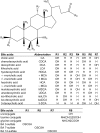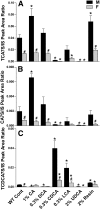Effects of feeding bile acids and a bile acid sequestrant on hepatic bile acid composition in mice
- PMID: 20671298
- PMCID: PMC2952563
- DOI: 10.1194/jlr.M007641
Effects of feeding bile acids and a bile acid sequestrant on hepatic bile acid composition in mice
Abstract
An improved ultra performance liquid chromatography-tandem mass spectrometry (UPLC/MS/MS) method was established for the simultaneous analysis of various bile acids (BA) and applied to investigate liver BA content in C57BL/6 mice fed 1% cholic acid (CA), 0.3% deoxycholic acid (DCA), 0.3% chenodeoxycholic acid (CDCA), 0.3% lithocholic acid (LCA), 3% ursodeoxycholic acid (UDCA), or 2% cholestyramine (resin). Results indicate that mice have a remarkable ability to maintain liver BA concentrations. The BA profiles in mouse livers were similar between CA and DCA feedings, as well as between CDCA and LCA feedings. The mRNA expression of Cytochrome P450 7a1 (Cyp7a1) was suppressed by all BA feedings, whereas Cyp7b1 was suppressed only by CA and UDCA feedings. Gender differences in liver BA composition were observed after feeding CA, DCA, CDCA, and LCA, but they were not prominent after feeding UDCA. Sulfation of CA and CDCA was found at the 7-OH position, and it was increased by feeding CA or CDCA more in male than female mice. In contrast, sulfation of LCA and taurolithocholic acid (TLCA) was female-predominant, and it was increased by feeding UDCA and LCA. In summary, the present systematic study on BA metabolism in mice will aid in interpreting BA-mediated gene regulation and hepatotoxicity.
Figures








References
-
- Chiang J. Y. 2002. Bile acid regulation of gene expression: roles of nuclear hormone receptors. Endocr. Rev. 23: 443–463. - PubMed
-
- Botham K. M., Boyd G. S. 1983. The metabolism of chenodeoxycholic acid to beta-muricholic acid in rat liver. Eur. J. Biochem. 134: 191–196. - PubMed
-
- Hofmann A. F., Sjovall J., Kurz G., Radominska A., Schteingart C. D., Tint G. S., Vlahcevic Z. R., Setchell K. D. 1992. A proposed nomenclature for bile acids. J. Lipid Res. 33: 599–604. - PubMed
-
- Deo A. K., Bandiera S. M. 2008. Identification of human hepatic cytochrome p450 enzymes involved in the biotransformation of cholic and chenodeoxycholic acid. Drug Metab. Dispos. 36: 1983–1991. - PubMed
Publication types
MeSH terms
Substances
Grants and funding
LinkOut - more resources
Full Text Sources
Other Literature Sources
Medical
Research Materials

